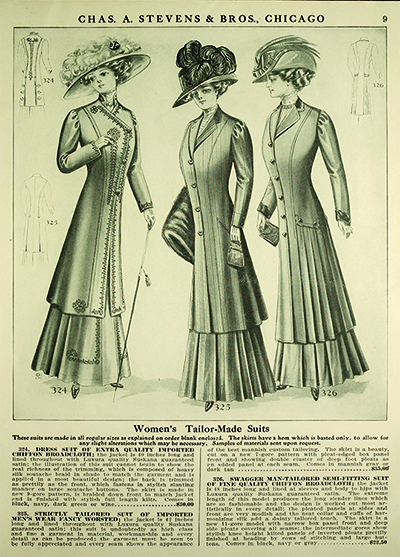1900 - 1910s: New Forms
 |
 |
 |
 |
 |
 |
 |
 |

The catalog page advertises the Chicago store where the walking suit (at right) was purchased. Charles Anthony Stevens (1859-1932) was born in Colchester, Illinois, and came to Chicago in 1890 to open a dry goods and women's apparel store on State Street. The operations later expanded to include stores around the city and suburbs, and closed in 1988. Chas. A. Stevens & Bros. catalog, Chicago, Illinois, Fall/Winter 1908/1909, Lawerence J. Gutter Collection of Chicagoana (University of Illinois at Chicago) ICIU Archive.org.
By 1902, Queen Victoria’s reign had ended and her son, Edward VII, had become the new British monarch. The Edwardian Period lasted until World War I.
The end of the Victorian Era coincided with new freedoms. Automobiles became increasingly available, creating a newfound private space for the young. Telephones broke through and reached across private spaces to become a tool of romance. America’s urban population also jumped from 28% in 1880 to 52% in 1920, changing the contexts of many women’s lives from small town conformity to the greater freedom of urban anonymity. During World War I, more women entered the workforce than ever before. Society was transforming, leading to dramatic fashion changes in the first two decades of the twentieth century.
Queen Victoria had ruled so long that Edward was 61 years old when crowned. King Edward had a preference for mature women, resulting in fashionable dress that embraced older body forms. According to fashion historian Allison Gernsheim, “these were the great days of mature beauty.” One fashionable outgrowth of this was the popularity of the “S” shaped silhouette. Sometimes called a “pouter pigeon,” this look was created by a monobosom corset that pushed the breasts up and the lower body backwards. To complete the “S” form, small pads were placed under the skirt’s backside. While dresses of this style were looser with lighter fabric, the monobosom corset, forming the fashionable body shape, was equally deleterious to women’s health as earlier tightly laced, cinched waist corsets.
Dress reformers had been working since the 1850s to modify the way women dressed, and by 1910 they had broken through. The corseted “S” lines gave way in the early years of the twentieth century [after 1908] to straighter lines. Dresses often hung from the shoulder with modest camisoles and narrow petticoats. Paul Poiret, a French fashion designer, led the way with this new dress form. He looked to Japanese kimonos, Ottoman/Turkish dress and to Greek chitons as stylistic influences. His designs focused on straight lines, rectangular panels sewn together to create a flatness in appearance. His designs radically changed the lines of Western women’s fashion.
Among the most popular dress forms were the “lingerie dresses,” where emphasis centered on lace and embroidered details; pastels and shades of white were among the most popular colors. These were known as “lingerie dresses” because cottons, linens, and silks were traditional undergarment materials, and the lace trim reflected those found on chemise and petticoats. These airy light-weight garments were comfortable and allowed great freedom of movement.
